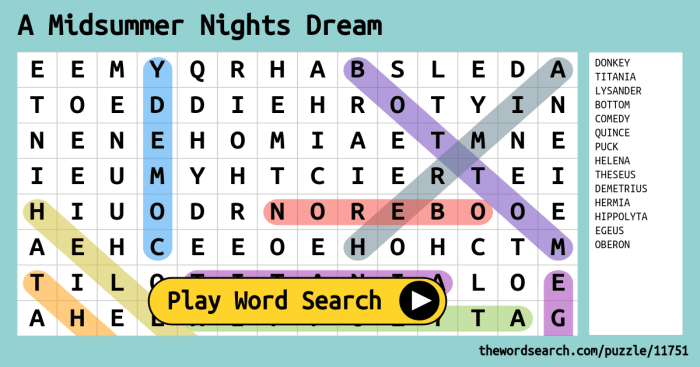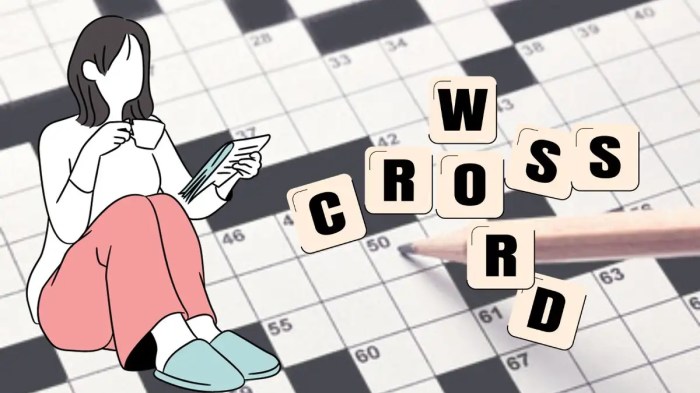Embark on a captivating journey through A Midsummer Night’s Dream crossword puzzle answers, where the boundaries between reality and illusion blur, and the power of love triumphs over chaos. Dive into the enchanting world of Shakespeare’s beloved comedy, where mischievous fairies, tangled relationships, and a dreamlike atmosphere intertwine to create a timeless masterpiece.
From the whimsical Puck to the lovelorn Demetrius, each character plays a pivotal role in this enchanting tale. The play’s themes of love, transformation, and the interplay between reality and dreams are explored through a series of witty wordplay and intricate puzzles, making A Midsummer Night’s Dream a delight for crossword enthusiasts and Shakespeare aficionados alike.
A Midsummer Night’s Dream Crossword Puzzle Answers

A Midsummer Night’s Dream is one of Shakespeare’s most beloved comedies. The play is full of magic, mischief, and romance, and it has been adapted into numerous films, stage productions, and operas.
This crossword puzzle is a great way to test your knowledge of the play. The answers to the clues are all found in the text of the play.
Characters and their Roles
The play features a large cast of characters, including:
- Theseus: The Duke of Athens. He is engaged to Hippolyta, the Queen of the Amazons.
- Hippolyta: The Queen of the Amazons. She is engaged to Theseus.
- Egeus: Hermia’s father. He wants Hermia to marry Demetrius.
- Hermia: Egeus’s daughter. She is in love with Lysander.
- Lysander: A young man who is in love with Hermia.
- Demetrius: A young man who is in love with Helena.
- Helena: A young woman who is in love with Demetrius.
- Puck: A mischievous fairy who serves Oberon.
- Oberon: The King of the Fairies.
- Titania: The Queen of the Fairies.
- Bottom: A weaver who is transformed into a donkey by Puck.
Themes and Symbolism, A midsummer night’s dream crossword puzzle answers
The play explores a number of themes, including:
- Love: The play is full of different kinds of love, from the romantic love between Hermia and Lysander to the unrequited love between Helena and Demetrius.
- Transformation: The play is full of characters who undergo transformations, both physical and emotional.
- Chaos: The play is set in a world of magic and chaos, where anything can happen.
Dramatic Structure
The play is divided into five acts. The first act introduces the characters and sets up the conflict. The second act takes place in the forest, where the characters are transformed by magic. The third act is the climax of the play, where the lovers are reunited.
The fourth act is a series of comic scenes, and the fifth act is the resolution of the play.
Cultural and Historical Context
A Midsummer Night’s Dream was written in the late 16th century. The play is thought to have been inspired by the wedding of William Stanley, the 6th Earl of Derby, to Elizabeth de Vere in 1595.
The play is full of references to classical mythology and literature. For example, the character of Puck is based on the Roman god Mercury.
Adaptations and Interpretations
A Midsummer Night’s Dream has been adapted into numerous films, stage productions, and operas. Some of the most notable adaptations include:
- The Dream(1984): A film adaptation directed by Michael Hoffman.
- A Midsummer Night’s Dream(1999): A film adaptation directed by Michael Radford.
- A Midsummer Night’s Dream(2016): A stage production directed by Simon Godwin.
Clarifying Questions: A Midsummer Night’s Dream Crossword Puzzle Answers
What is the significance of Puck in A Midsummer Night’s Dream?
Puck, the mischievous fairy, serves as a catalyst for the play’s central conflicts and provides comic relief. His love potion causes the tangled relationships among the lovers, leading to hilarious misunderstandings and ultimately, their reconciliation.
How does the forest setting contribute to the play’s atmosphere?
The forest in A Midsummer Night’s Dream represents a realm of transformation and chaos, where the boundaries between reality and illusion blur. It is a place where characters can escape their everyday lives and explore their true desires, leading to both confusion and self-discovery.
What is the significance of the play-within-a-play?
The play-within-a-play, performed by the mechanicals, serves as a humorous commentary on the main plot. It provides a meta-theatrical element that highlights the themes of illusion and reality, and allows Shakespeare to explore the nature of love and relationships from multiple perspectives.
